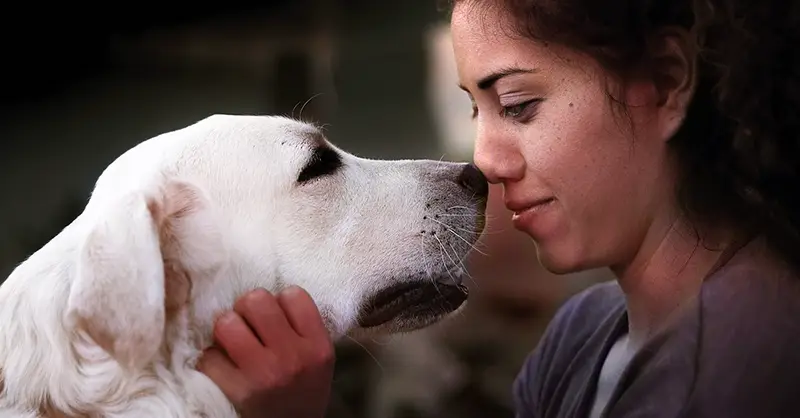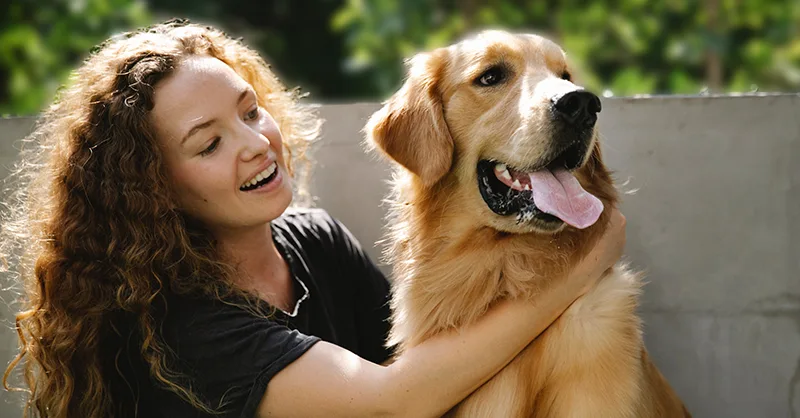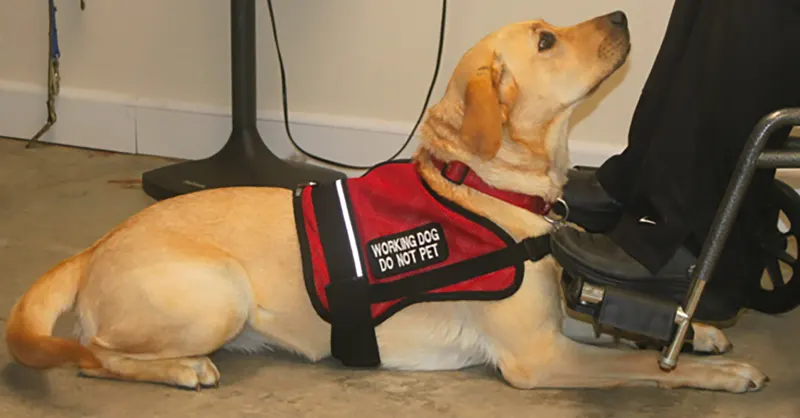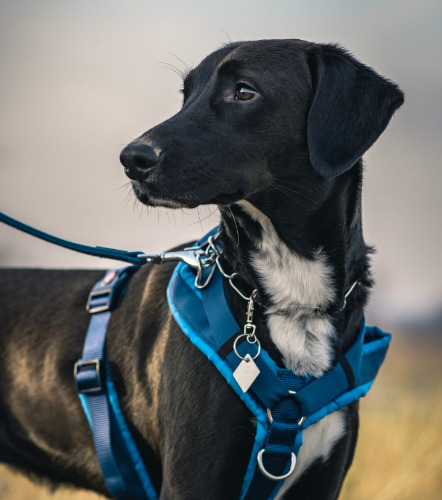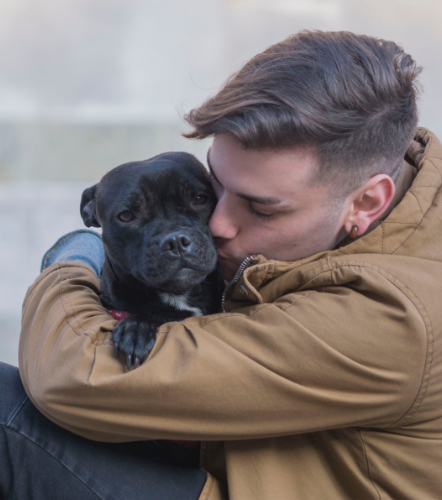Archive for the ‘Service Dog Tips’ Category
Quality doesn’t come cheap. Neither does a Service Dog. However, when considering how beneficial a well-trained Service Dog can be to the quality of life of its handler, then a Service Dog is priceless.
Nonetheless, according to the Freedom Service Dogs of America, the cost of a Service Dog is approximately $25,000. Let’s take a moment to break those numbers down.
What does a Service Dog entail?The ADA defines a Service Animal as a dog that is trained to perform tasks for the benefit of a person with a disability. The disability can be a physical disability or any form of mental illness that limits one or more major life activities. Service Dogs must be specifically trained to assist in easing the symptoms caused by the qualifying disability. In return, Service Dogs can accompany their handlers almost anywhere.
Acquiring and training a Service Dog is costly. And, as with any four-legged friend, follow-up expenses are needed to make sure the Service Dog can perform at their best. Having a Service Dog does come with some dismay from other individuals who may not understand the handler’s needs. Thus, some handlers decide to also register their Service Dog in order to make the dog’s purpose more transparent.
Purchasing a Service DogSome handlers choose to buy an already trained Service Dog. Out of all the options, this is the costliest, but the most convenient and efficient choice.
Service Dogs for full purchase are bred to be Service Dogs. There are specific breeders who select dogs for their health, temperament, intelligence, etc. These dogs are chosen for qualities required in Service Dogs. Some dogs are also purchased from other non-service dog breeders if a dog shows exceptional traits that would be fit for Service Dogs. In short, fully trained Service Dogs for purchase are selected and trained to be service dogs from birth, thus a higher price tag.
Professionally trained Service Dogs run from $25,000-50,000. Young girl with her professionally trained service dog. Training Costs Hiring a Dog TrainerThe training a Service Dog receives is not the same kind of training that a regular dog receives at the pet store.
Depending on the dog and what services are going to be required, obedience training can take anywhere from four to six months of extensive work.
Afterward, the potential Service Dog will need to be able to perform all the tasks in different environments–from shopping malls to hospitals and sporting events. Training in various settings may take months or years, depending on the dog and service. Because training depends on many variables, dog trainers are typically paid by the hour, which can cost $150-$250.
On the whole, training can cost from $20,000-$30,000. Training the Dog YourselfAs always, the cost to train your own Service Dog is dependent on a number of variables, making the prices fluctuate:
The dog’s age The dog’s temperament The dog and the handler’s ability to learn The amount of time, effort, and consistency spentSome people are surprised to find that Service Dog training is very rigorous and regulated. However, this ensures that the dogs can accomplish their tasks safely and continue to be held in high esteem as a whole industry.
Mandatory introductory seminars, an initial evaluation, a planning session, an application, a Working Dog Good Citizen Class, and a public access test costs start at about $1,000-$2,000. Ancillary CostsService Dogs are living, breathing, thinking animals. They require adequate veterinary care like all pets and need to be fed and groomed.
Depending on the dog, veterinary care may cost an average of $1,000-$2,000 a year, along with grooming costs. Feeding costs for an average dog maybe $300 a year. Registering a service dog can cost $100-$200. A specially trained service dog hugging their handler. The Cost of Your Well-beingObtaining a Service Dog is a big decision and a substantial investment. However, the long-lasting benefits on the handler’s well-being could by far excel the costs. A Service Dog may be the key to living a fuller life. And there is no price you can place on that.
Unlike most dogs, Service Dogs go to work every day to fulfill their job in supporting their handlers with their specific needs. Just like humans, to do their work, they might need a uniform and tools to make the job easier. A shopping list of essential supplies for a Service Dog could include the following items:
Vests ID Cards Paw Mittens and Booties Collar Leash Head Halter Harness Toilet or Waste Kits Clickers Muzzle Toys, Treats, and Relaxation VestsThe vest is an essential Service Dog gear. Although Service Dogs aren’t legally required to wear one, vests do provide a level of authority and convenience. They are also a courtesy to bystanders by visually communicating that a dog is working in an official capacity.
The vest grants entry into an establishment or area where animals would be otherwise be prohibited. The American Disabilities Act allows Service Dogs into any spaces where their owner goes, and a vest alerts everyone that a dog is a Service Dog and must accompany its owner.
The most popular, and useful, style is the Cape Style Service Dog vest. It’s easy to place over the dog and provides enough areas with pockets. A vest should fit snugly around the dog, without restricting the dog’s movement. The vest should also be padded and made of a non-abrasive material to reduce friction and injury to the dog.
A patch can be placed on a Service Dog vest to provide further information to others. A “no petting” patch might also help deter people who don’t know that Service Dogs should not be petted while they are at work. Although not necessary, patches can communicate whatever a service dog owner thinks is necessary for others to know.
ID CardsAn ID card is not necessary for a service dog. However, a Service Dog ID Card can provide the following benefits:
Permits access to areas denied to other dogs. Helps educate the public of the dog’s access rights as Service Dog. Builds confidence to travel with the Service Dog. Provides additional documentation for how long the Service Dog has been in service. Gives access to the Service Dog Registration online, on a mobile device. Paw Mittens and BootiesService Dogs follow their owners everywhere, and their paws travel on a variety of terrains. Their paws may need protection from hazards like hot pavements and frozen ground. Paw mittens and booties help to keep their paws free from external injuries.
CollarService Dogs spend a majority of their day leashed and collared. Collars also identify dogs as Service Dogs, and a dog tag or other accessories can be attached.
It’s crucial to find a collar that fits correctly and doesn’t abrade the dog’s skin. There are a variety of materials to choose from. It’s best to select collars based on the dog’s tasks and what kind of dog breed they are.
Boxer Service Dog with a vest, collar, and leash, taking a rest. LeashService Dogs are exceptionally well trained and will not leave their owner’s side. However, for the comfort and reassurance of the public, leashing a Service Dog is necessary when out and about. Leashes come in a wide range of lengths, though the recommended length is 4-6 feet.
What type of material to choose for a leash depends on the dog breed and task. For example, a large service dog that helps to maneuver a wheelchair may require a sturdier, thicker leash.
Head HalterTypically, head halters are devices used in the training of Service Dog puppies. However, head halters can also be useful in cases where owners may be unable to communicate with a Service Dog. The head halters allow an owner to give immediate directions, without the need for verbal or visual cues, just by tugging at the halter.
Show everyone that the rights of your Service Dog should be respected. Get your Service Dog registered.
HarnessA harness provides a way for Service Dogs to pull their owner or guide them out of an area. A harness also allows a Service Dog to pull on a wheelchair or provide balance to its handler. The harness spreads pressure throughout the chest and shoulders of a Service Dog, allowing the dog to manage heavy weights without injury.
Supplies your Service Dog might require. Toilet or Waste KitsEven Service Dogs have little “accidents”. Although very rare, a Service Dog may be unable to hold their business for later or may unexpectedly become ill. In these situations, having a waste kit on hand can make life a whole lot easier for both, the owner and the service dog.
Dog waste kits can contain plastic waste bags, a waterproof pad, towel wipes, and hand sanitizer. Owners can add whatever else they feel might be necessary to provide a quick clean up.
ClickersClickers are mainly a training device for Service Dogs. They’re called “clickers” because they emit a clicking sound initiated by the trainer. The clicking sound provides immediate feedback, instead of a positive verbal response from the owner, which may be confusing for a puppy. For example, a trainer may initiate a clicking sound immediately after a dog sits after he’s asked to “sit.” The dog identifies the clicking sound as positive feedback that he performed the task correctly.
A fully-equipped Service Dog on duty. MuzzleBecause Service Dogs undergo extensive training, they don’t require muzzles. Though muzzles aren’t necessary for Service Dogs, they do have a role in certain situations. When in extremely crowded areas or locations where there may be numerous unsupervised children, a muzzle can provide any bystanders with a sense of security. Some people are fearful of dogs in general, and having a muzzle on a Service Dog can provide a degree of reassurance for the public. If a muzzle impedes on a Service Dog’s tasks, however, then the muzzle is not recommended for use.
Service Dogs are trained to be non-violent and tolerate any situation. However, if a Service Dog is injured, a muzzle may be required. Even the most well-trained dogs may bark, nip or bite when they have an injury.
Toys, Treats, and RelaxationAt the end of the day, Service Dogs are just like humans—they need to rest. When they’re off duty, Service Dogs are just like any other dogs. They enjoy playing with toys, being silly, and letting their pent up energy loose. Toys and activity are good for their wellbeing and make for better Service Dogs.
Healthy treats can provide positive re-enforcement for dogs and promote bonding with owners. Making time for relaxation and allowing Service Dogs time off to be regular dogs creates a work-life balance—something even Service Dogs need.
A Service Dog in his favorite collar having some off time at the beach. ConclusionService Dogs don’t require a ton of expensive gear, but they do need the basics. Some voluntary items, like a harness and vest, may depend on the owner’s needs and wishes. Others, like an ID card or a legitimate certification, can help handlers build more confidence bringing their Service Dog along.
But never forget, although Service Dogs take care of humans, they also need to be taken care of simply as a dog. Despite all the training and supplies, a Service Dog needs understanding, nurturing, care, and some time off to be a dog.
A person with a mental illness may struggle to accomplish daily life activities. When in need, some individuals depend on family, friends, or caretakers, while others rely on Psychiatric Service Dog. A Psychiatric Service Dog is a support for a person with a mental illness to help complete their everyday tasks.
Definition of a Psychiatric Service DogA Psychiatric Service Dog falls under the category of Service Animals. These are dogs or miniature horses that assist a person with a disability with tasks that directly relate to their disorder. Per Americans with Disabilities Act (ADA), a disability is a physical, medical, or mental disorder that impairs their daily activities. Originally, Service Dogs were only used for individuals with physical disabilities. As the number of other disorders grew, The ADA service dog laws conformed to the increasing numbers of people in need and began to allow Service Dogs for individuals with mental disabilities, and calling them Psychiatric Service Dogs.
Service Dog watching over his owner in the pool Mental Illnesses a Psychiatric Service Dog can help withTo qualify for a Psychiatric Service Dog, a person must have a diagnosis of mental illness from a medical professional. Several mental illnesses qualify as a psychiatric diagnosis. Among those are:
Generalized Anxiety Disorder Panic Attacks Obsessive-Compulsive Disorder Eating Disorders Post-Traumatic Stress Disorder (PTSD) Schizophrenia AgoraphobiaIf you are interested in registering your trained psychiatric service dog, the below image is a helpful guide for service dog registration. We recommend saving this or sending it a loved one who may benefit from having a service dog.
The best breeds for Psychiatric Service DogsTo find a Psychiatric Service Dog that fits the individual’s situation, they must look at several factors, such as breed, temperament, and trainability. Dog breeds that excel in this type of work and tend to enjoy service work are:
Labrador Retrievers German Shepherds Border Collies Poodles Golden RetrieversThese breeds share similar traits, such as high levels of trainability, desire to please, intense focus, and generally good temperament. These characteristics go a long way in training and allow them not only to learn the tasks needed by their handler but to form a strong bond. It’s important to choose a dog that enjoys working on specific tasks—if a dog struggles to learn new skills, or appears to be in distress while training, they may not be a good fit for service work.
Dogs with desirable working traits enjoy their responsibilities as Psychiatric Service Dog and will serve their handlers best.
Golden Retrievers make great Psychiatric Service Dogs Tasks a Psychiatric Service Dog providesOnce a handler identifies their ideal Psychiatric Service Dog, they need to think about what the dog can do to assist them. Each disability has different factors that impact an individual’s daily life. The goal with a PSD is to discover what they can do to help ease or even eliminate the handler’s undesirable symptoms. What a Psychiatric Service Dog needs to do depends on their handler’s demands, which again depends on their mental illness. Here are some examples based on different mental disorders:
Fetching medication for a person with depression who is unable to leave their bed Accompanying a person who has agoraphobia to go outside Detecting a panic attack and providing physical comfort until it subsides Fetching a phone for a person with anxiety so they can reach out for help Providing physical stimulation for a person with obsessive-compulsive disorder to distract them from their rituals Waking up a person with post-traumatic stress disorder who is experiencing nightmares or night terrors A Psychiatric Service Dog to fitThousands of individuals nationwide benefit from the assistance of a PSD. As everyone’s needs are different, each Service Dog is trained to complete distinct tasks that benefit their handlers. Continuous, honest communication with the therapist can help to determine what symptoms need extra support. And that insight will dictate what their Psychiatric Service Dog can do to help live their lives independently, safely, and as fulfilling as possible.
